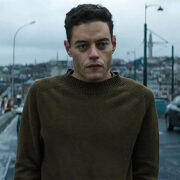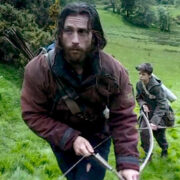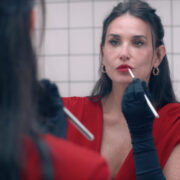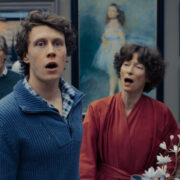Blood In The Ice Cream: A Deeper Look At The CORNETTO TRILOGY

Graduate of New York University's Dramatic Writing program. Novelist, short…
It’s one of the most viscerally violent images in film: a broken steeple has just tumbled from atop the tower of a village castle and landed (pointy part down) on the head of a geeky, innocent small-town journalist. The stone splits his head apart and pierces his body, spraying blood on our protagonist, a policeman (sorry, “officer”). The dying man takes a few steps forward and then falls to the ground.
And part of you laughs in disbelief. Because this movie is supposed to be a comedy.
The Trilogy
Hot Fuzz was released nearly ten years ago now, the second in a trio of films known unofficially as “The Cornetto Trilogy.” Sandwiched in between Shaun of the Dead and The World’s End, it is a brilliant collaboration between director Edgar Wright and stars Simon Pegg, who penned the scripts along with Wright, and Nick Frost. The films are billed as comedies, serving as less serious-minded entries in genres as diverse as zombie horror, conspiracy thriller, and sci-fi body invasion.
To view them only for their laughs, however, is to give them less credit than they deserve. While each film is full of visual gags, quick puns, and clever payoffs, there are some dark undercurrents in the stories of Wright and Pegg.
Point Break or Bad Boys II?
The foot-tapping title sequence to Shaun of the Dead shows levity in its portrayal of people stepping through menial lives as if half asleep. In those opening frames, the Cornetto Trilogy established one of its most prevalent themes, the inability to push oneself toward change. All three films focus on characters who are burdened by the routine of their lives, yet seem unable to break away from repetition. Pegg’s Shaun is no exception, his own noncommittal laziness threatening to turn him into the living dead.
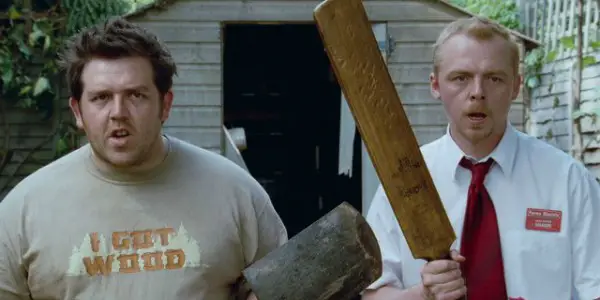
Shaun is a low-level manager at an electronics store, where he ineffectively tries to motivate his teenage workers. He thinks being a slacker is cool until it destroys his relationship with his girlfriend, Liz (Kate Ashfield). On a drunken bender, Shaun vows to win her back. His efforts, unfortunately, coincide with the zombie apocalypse.
From here, Shaun is a look at the inner turmoil of a mind attached to adolescence yet burdened by adulthood. His only hope at survival is the abandonment of his own angsty comforts: a friendship with Frost’s lazy stoner, anger at the stepfather who long ago invaded his life (Bill Nighy), and a reliance on others to solve his problems. If he can’t let go of those things, he’ll never grow up. And in this case, he’ll never survive.
In Hot Fuzz, Pegg’s Nicholas Angel is reassigned from his post in London to Sandford, a rural village. There, he begins to see the traces of a conspiracy, which he pursues with the vigor he would a big city crime ring. Against him is the town’s NWA (Neighborhood Watch Alliance), a group of senior citizens who maintain that Sandford is a quiet, peaceful place. As in Shaun, their resistance against the unfamiliar (and love of good classical theatre) causes violence and death, this time at the hands of an aging generation that refuses to give up their power.
The third part of the trilogy, The World’s End, brings us Gary King (Pegg), who drags his estranged school friends on a pub crawl that they were unable to complete as students. Here, Wright and Pegg give us the conflicts that arise when those permanently stuck in youth collide with those in the rut of adulthood. It has a broader spectrum, investigating the cyclical nature of life through the parallels between the story of the original crawl and the events that follow. In fact, the film begins and ends with the image of a circle: one an AA-type meeting, the other a cylindrical HQ for invading extraterrestrials.
The World’s End, more than the other films, illustrates the violence of the changes that force a man-child to grow up. He discovers the illusion of who he once was (and the existence of androids that have taken over his childhood town, naturally) and through his selfish denial, he burns down the world around him. All while fighting robots full of blue stuff.
Sorry, Philip
“Stop pointing that gun at my mom!” screams Shaun, moments after discovering that his mother (Penelope Wilton) has hidden a fatal bite on her wrist. As always, he’s hesitant to do what he must and another has stepped in to take his responsibility. In the midst of the insane hilarity of Shaun of the Dead is this heart-wrenching scene in which he must be the one to sever the strongest of ties to his own youth. Similar, but in a more literal way, is the fate of Gary King when he finally comes face-to-face with the “blank” meant to restore him to his glory days.
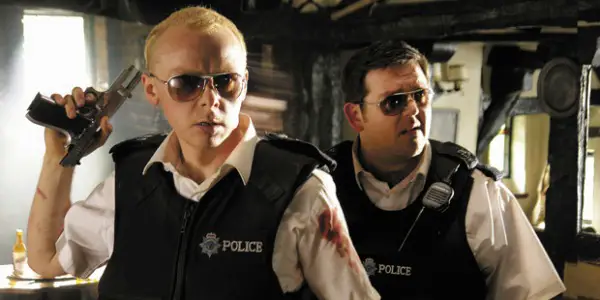
Family is often shown as an adolescent comfort in the films of the Cornetto Trilogy, though it is also the thing holding its characters back. This is true in both Shaun and Hot Fuzz, where characters are defined by parental betrayal (Shaun’s mom marrying his stepfather, the dark intentions of Danny’s father). In Fuzz, Danny’s kind nature seems to be defined by the absence of his mother, while Shaun seems to fixate on the presence of Nighy’s Phil. There’s even an excitement in his voice when he decides that killing Phil must be a part of their survival plan.
The World’s End does seem to buck this trend. The failing marriage of Frost’s Andy is what propels him to survive, something completely lost on Gary, who seems determined only to live for the next pint. What’s interesting, though, is that dead parents are referenced as plot points in all three of the films. They are part of the pasts that have imprisoned the characters’ presents.
Gary King Is Back On the Horse
Perhaps the darkest undercurrent in the Cornetto Trilogy is its look at mental health and addiction. Gary King is the most obvious example: he’s clearly an alcoholic from his first appearance in World’s End and his disease only becomes more clear as the pub crawl lumbers on. While his affliction is often played for laughs in the first two acts of the film, his final confrontation with Andy wells with catharsis. It is the actors’ strongest scene in the trilogy and shows their dramatic ability (Frost is particularly great in World’s End, breaking away from the oafish Ed and Danny).
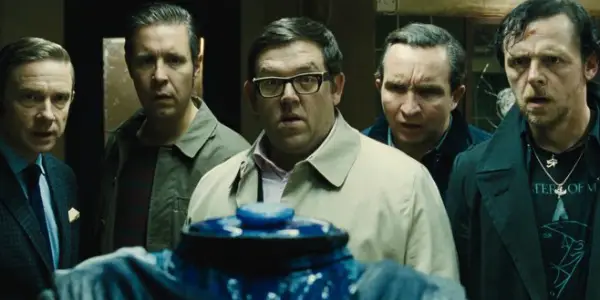
When he reveals the bandages covering his wrists (evoking imagery from Shaun’s mother post-bite and harking back to the suicide of Danny’s mother before the events of Hot Fuzz), Gary King exposes the depth of his psychosis. While neither Shaun nor Angel seem so deeply disturbed, both are affected by a pervasive pub culture that contributes to a great many of their causes. Shaun basks in the environment of the Winchester, a pub where he decides to wait out the herding dead. Angel first meets a drunk Danny in a pub in Hot Fuzz, where his adherence to the rules immediately casts him as an outsider.
Let’s Boo-Boo
Make no mistake: Edgar Wright, Simon Pegg, and Nick Frost crafted three of the funniest modern films with the Cornetto Trilogy. Each is incredibly clever and stuffed with belly laughs that come from both the writing and the spot-on performances. Even behind the camera, Wright pulls off some of the greatest visual jokes in film. But under this cover of comedy exist characters full of humanity and pain.
As the trilogy went on, its entries seemed to rely less on blood-splattered shock. Maybe, just as their characters grew to maturity or died trying, the filmmakers were becoming surer of their ability to tell emotionally honest stories within some of the funniest comedies of the century so far. My controversial belief that The World’s End is the best in the trilogy is based not on laughs (although it has many of my favorite funny moments, as well), but on the depth of its characters. And with that comes a rarity: a series of nearly perfect comedies that become richer with every watch.
Which of the Cornetto Trilogy films is your favorite? Which characters do you find to be the most compelling? Have I overthought this whole thing? Let us know in the comments.
Does content like this matter to you?
Become a Member and support film journalism. Unlock access to all of Film Inquiry`s great articles. Join a community of like-minded readers who are passionate about cinema - get access to our private members Network, give back to independent filmmakers, and more.
Graduate of New York University's Dramatic Writing program. Novelist, short story writer, and podcaster. Batman and Star Wars nerd.





